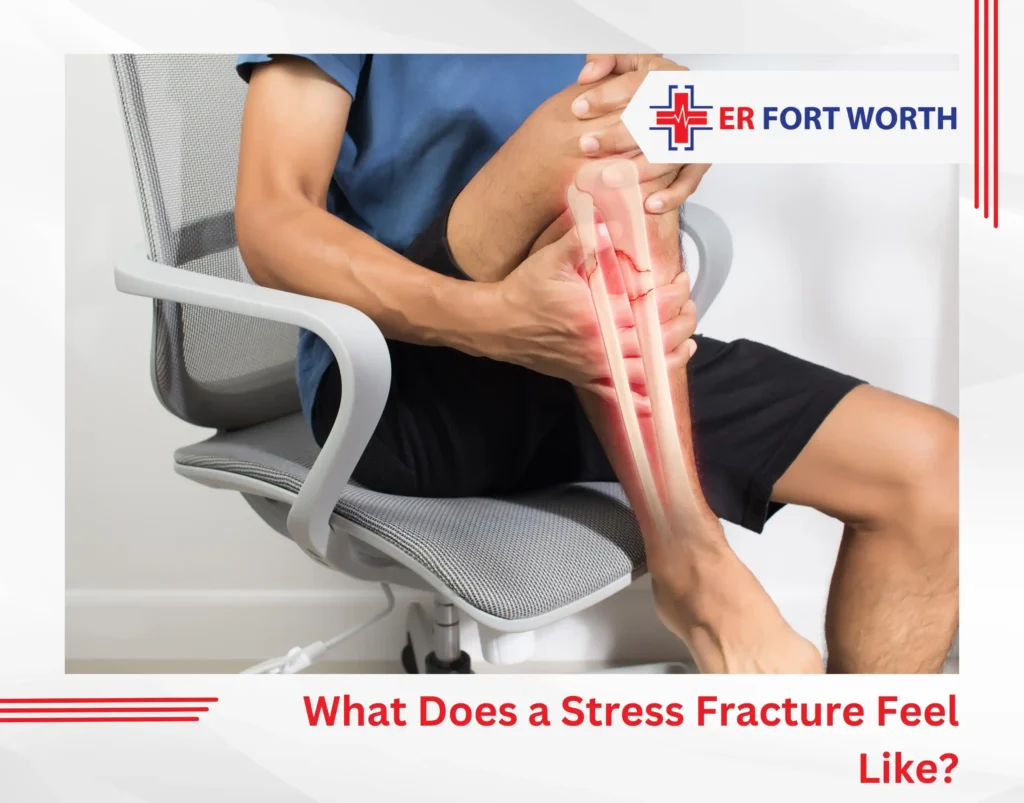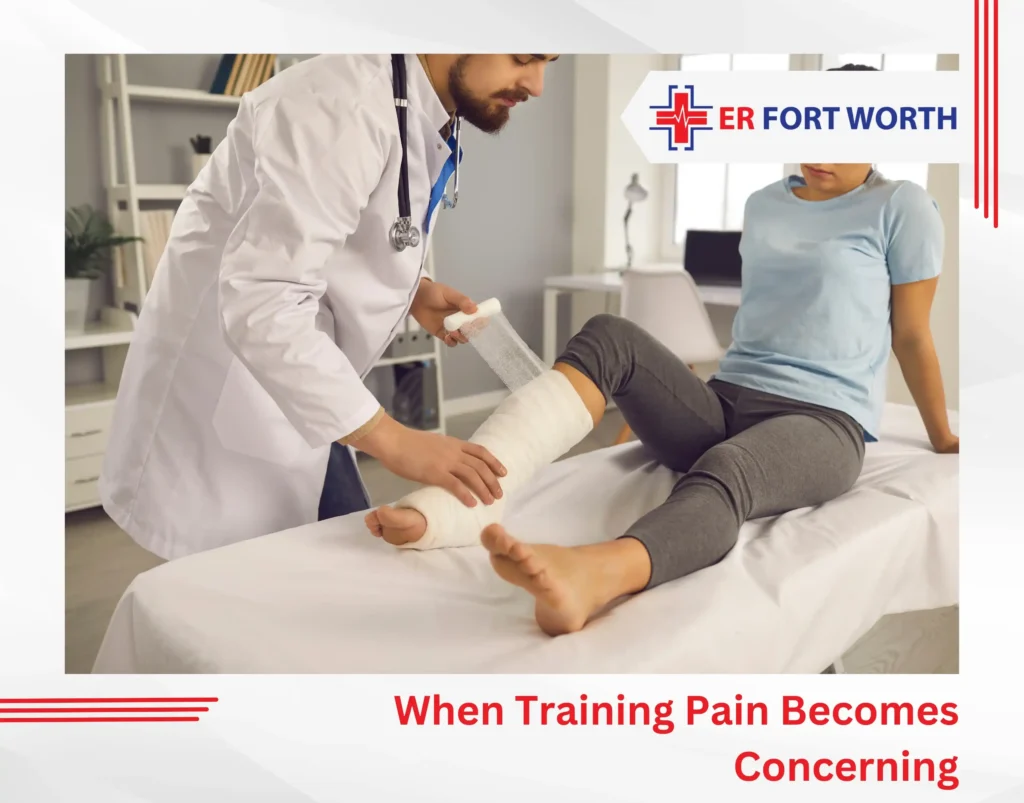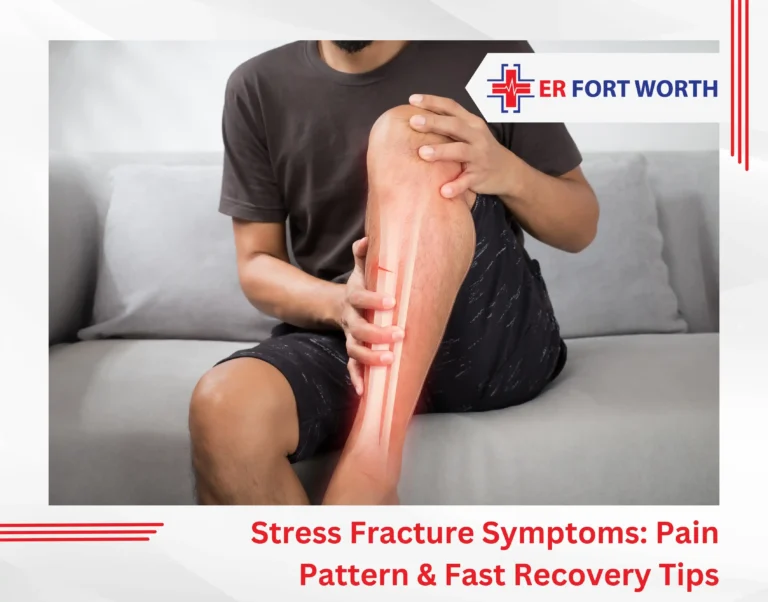Many people brush off sharp pain in the foot, shin, or hip as simple soreness or muscle fatigue. But if that pain doesn’t go away with rest or keeps returning every time you’re active, it might signal a stress fracture, aka hairline fracture.
A stress fracture is a small crack or severe bruising within a bone. Unlike a traumatic fracture, which happens suddenly from a fall or impact, these fractures develop over time from repeated pressure on the bone.
Stress fracture symptoms include bone tenderness when pressed, swelling, and sharp, localized pain that worsens with weight-bearing activities like running or jumping. They’re common in athletes, military personnel, dancers, and people with active lifestyles or jobs that involve repetitive motion.
What Does a Stress Fracture Feel Like?

The answer varies depending on the location and severity, but certain pain patterns are consistent. In general, Stress Fracture Symptoms feel like dull aching pain and are usually accompanied by painful swelling around the fracture. The pain is localized, meaning that you can pinpoint the exact point of the fracture.
Stress fracture is characterized by:
- Localized pain: You can usually point to one specific spot where it hurts.
- Activity-related pain: The pain worsens with activity and eases with rest.
- Progressive intensity: The discomfort starts as a dull ache but grows more intense over time, especially if ignored.
- Pain with pressure: Pressing directly on the affected area can be noticeably painful.
- Persistent discomfort: Eventually, the pain may be present even during rest or at night.
In early stages, you might feel a dull soreness only after prolonged activity. But as the bone stress injury progresses, the pain becomes sharper, more frequent, and harder to ignore.
Common Stress Fracture Symptoms
Unlike muscle or tendon pain, which tends to be diffuse and broad, stress fracture pain is pinpointed and predictable. Here are the major stress fracture symptoms:
- Sharp or aching pain in a focused area
- Swelling or mild bruising
- Increased pain during high-impact movements
- Pain that worsens day after day
- Tenderness when pressing on the bone
- Limping or altered gait
Recognizing these symptoms early can help prevent further damage to the affected bone.
Locations Where Stress Fractures Are Most Common
Stress fractures can affect almost any bone in the body, but they most frequently occur in:
- Tibia (shinbone) – especially among runners
- Metatarsals (foot bones) – often in dancers and military recruits
- Femur (thighbone) – particularly in long-distance athletes
- Pelvis – in endurance runners and gymnasts
- Navicular (mid-foot) – in high-impact sports
- Ribs – in rowers or golfers due to repetitive torso twisting
Knowing where stress fractures are most likely to occur can help you assess whether your pain fits a concerning pattern.
What Causes a Bone Stress Injury?
A bone stress injury develops when the bone experiences repeated strain without sufficient recovery time. This leads to a breakdown in the bone remodeling process.
Common causes of bone Stress Fracture Symptoms include:
- Sudden increases in physical activity: Jumping into a new workout plan or increasing mileage too quickly is a leading cause of stress fractures.
- Poor biomechanics or form: Incorrect posture or movement technique can place extra stress on certain bones.
- Inadequate footwear: Shoes that lack proper cushioning or support can increase impact on the feet and legs.
- Low bone density: Conditions like osteoporosis or osteopenia reduce the bone’s ability to withstand stress.
- Nutritional deficiencies: Lack of calcium, vitamin D, or overall energy intake can impair bone strength and recovery.
- Female athlete triad: Low energy availability, menstrual dysfunction, and low bone mineral density increase the risk of stress fractures in women.
Even active individuals with good health habits can develop stress fracture symptoms if they don’t allow enough time for recovery between workouts.
Stress Fracture Diagnosis
If your pain has become persistent, localized, and activity-dependent, it’s time to consider a stress fracture diagnosis. Many people ignore early signs, hoping the discomfort will go away with rest. But without proper diagnosis and care, the fracture can worsen.
Here’s what the diagnosis process may include:
- Physical Exam
A clinician will evaluate your symptoms, look for swelling, and test for tenderness over the bone. They may ask about your activity levels, footwear, and recent changes in training routines.
- Imaging Tests
- X-rays are usually the first step, but early stress fractures often don’t show up.
- MRI is the most sensitive test and can detect stress fractures in their early stages.
- Bone scans may also help identify areas of increased activity or bone remodeling.
Getting an accurate stress fracture diagnosis early allows for faster treatment and reduces the risk of long-term complications. At Fort Worth ER, our medical team uses advanced imaging and tests to spot stress fractures and begin prompt treatment.
What Is the Fastest Way to Heal a Stress Fracture?

The fastest way to heal a stress fracture involves immediate rest, proper nutrition with adequate calcium and vitamin D, and using walking boots or crutches to remove stress from the injured bone. Most stress fractures heal within 6-8 weeks when managed correctly from the start.
Essential Steps for Rapid Stress Fracture Healing
- Complete rest from high-impact activities for several weeks
- Use of walking boots or crutches to offload stress from the bone
- Ice therapy to reduce swelling and discomfort during the first 48 hours
- Pain management through appropriate medication as directed by your physician
Key Factors That Accelerate Stress Fracture Recovery
- Proper nutrition with adequate calcium, vitamin D, and protein intake to support bone regeneration
- Quality sleep of 7-9 hours nightly, as growth hormone release peaks during deep sleep phases
- Weight management to reduce stress on healing bones, particularly for lower extremity fractures
- Avoiding smoking and excessive alcohol consumption, both of which significantly impair bone healing
Advanced Treatment Options for Stress Fracture
- Physical therapy for safe return to activity once initial pain subsides
- Targeted rehabilitation to address biomechanical issues that contributed to the injury
- Bone stimulators for bones that are slow to heal
The fastest healing occurs when treatment begins immediately after diagnosis. High-risk fractures in areas like the navicular or fifth metatarsal may require 12-16 weeks, but most heal within the standard timeframe when these protocols are followed consistently. Always consult your doctor when making treatment decisions.
Can Stress Fractures Be Prevented?
Yes! Prevention is possible and crucial, especially if you’ve experienced one before. Here’s how you can prevent stress fractures:
- Gradually increase training intensity rather than making abrupt changes
- Cross-train to avoid repetitive strain on the same bone groups
- Wear supportive, activity-appropriate shoes
- Address biomechanical issues with the help of a physical therapist
- Get adequate nutrition and rest
- Listen to your body, don’t push through pain that seems abnormal
Early detection of stress fracture symptoms and timely management can prevent the injury from progressing and keep you active and pain-free.
When Training Pain Becomes Concerning

Most athletes know the difference between typical muscle soreness and something more serious, but stress fractures create a confusing gray area. The pain often starts subtle and gradually worsens, making it difficult to pinpoint when normal discomfort crosses into injury territory.
The overlap between training fatigue and early stress fracture symptoms leaves many uncertain about whether to push through or seek help. Waiting and hoping the pain disappears often backfires. Stress fractures rarely resolve without proper rest, and continued activity on a developing crack can turn a 6-week recovery into a 6-month ordeal requiring more aggressive treatment.
If you’re experiencing pain that’s focused in one spot, gets worse with activity, and doesn’t improve after a few days of rest, it’s time to stop guessing and get the right care. The Fort Worth ER specializes in diagnosing orthopedic issues like stress fractures. Our team uses advanced imaging, lab tests, and targeted physical exams to catch problems early before they require more invasive treatment.
FAQs
1. How can I tell if it’s a stress fracture or just shin splints?
Shin splints usually cause diffuse pain along a broader area of the shin, while a bone stress injury like a stress fracture results in pinpoint pain that’s tender to the touch. If the pain becomes more severe during activity, doesn’t go away with rest, or makes hopping on one leg painful, it may be time for a proper stress fracture diagnosis.
2. Are there nutrition-related red flags for stress fractures?
Definitely. Low energy availability, vitamin D deficiency, and calcium imbalance can weaken bones over time, increasing the risk for bone stress injuries.
3. What is mistaken for a stress fracture?
Conditions like shin splints, tendonitis, and muscle strains are often confused with stress fractures.
4. Do stress fractures show on ultrasound?
Ultrasound may detect surrounding inflammation but usually misses early stress fractures.It lacks the sensitivity needed to visualize small bone cracks or subtle changes. MRI remains the preferred imaging tool for accurate stress fracture diagnosis.
5. How to tell the difference between a sprain and a stress fracture?
Sprains result from sudden trauma and cause swelling, bruising, and joint instability. A stress fracture develops over time and causes sharp, localized pain during weight-bearing. Pain that worsens with repetitive motion often points to a bone stress injury.
6. What is the hop test for a stress fracture?
The hop test involves hopping on the affected leg for 30 seconds. Sharp, pinpoint pain during or after hopping may indicate a stress fracture. While not diagnostic, a failed test suggests the Need For Medical Evaluation




